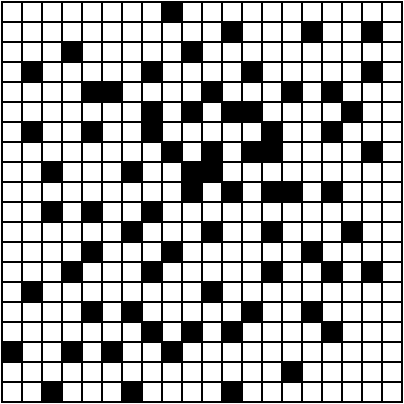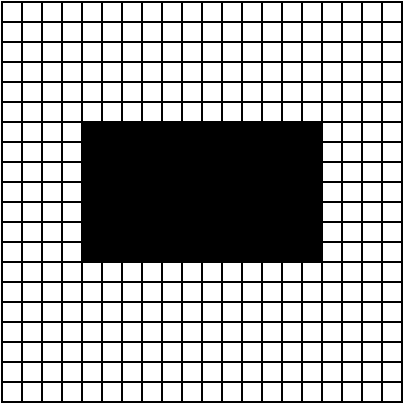"Good," I said. "This brings me to my next point: resisting entropy requires work. Everything naturally pulls towards high entropy states. If you want to resist that pull, then work is required.
Let's say I pour a box of puzzle pieces onto a table, and I represent those puzzle pieces with these black squares. You'd expect the pieces to fall on the table in a disordered state, right? Something like this?" I pointed to the diagram.

Zac nodded in agreement.
"So, would you be surprised if I poured the puzzle pieces onto the table, and they landed in this position?"

Zac nodded again.
"Why would you be surprised?" I asked.
"Because the probability of that happening is very low," he said.
"Exactly! Of all the different states you could find this system in, there is only one state that represents a finished puzzle. There are millions of states that represent an unfinished puzzle. Therefore, the probability that all the pieces land in that one 'finished puzzle' state is very, very low. It's much more likely that the pieces will fall into one of the millions of disordered states. To move a system from a disordered state of high entropy to an ordered state of low entropy requires work. You need to expend energy sorting through the puzzle pieces, finding the corners and edges, and snapping them all into place. Got it?"
"Got it," Zac said. "Resisting entropy requires work."
"Good. Now let's have a look at another example. Would you say your desk is neat and organized?"
"Yes."
"An organized desk represents a low entropy state. There are a minimal number of states the desk can be in to call it 'tidy.' For example, papers all need to be neatly stacked on top of one another. Pens all need to be in the pen holder. The stapler needs to be lined up or placed in some kind of neat position.
By contrast, there are many, many states the desk could be in to call it 'messy.' The papers could be anywhere; the pens could be anywhere; the stapler could be anywhere. Your desk will naturally pull towards a disordered 'messy' state. You resist this natural pull by constantly performing work to keep it in an ordered state: putting the pens away, stacking the papers, straightening up the stapler, etc."

"Stapler?" Zac gasped. "Who has a fucking stapler these days? Are we living in the nineties?"
"No."
"Then why is there a stapler on my desk?"
"I don't know, Zac. I also don't care."
"Well, I do. You are misrepresenting-"
"Zip it. I'm talking. Now, let's discuss reusable rockets."
Zac chuckled. "I've got a reusable rocket, if you know what I mean…"
"I don't know what you mean."
"I'm talking about my penis. Which is reusable. A rocket is a metaphor for my penis."
"Ah, makes sense now. Thank you for clarifying."
"You're most welcome, my friend."
"Shall we carry on?"
"Yes."
"Excellent," I continued. "We're going to begin looking at entropy resistance as a creative process. A whole bunch of holographic patterns emerge when you start analyzing entropy through this lens."

